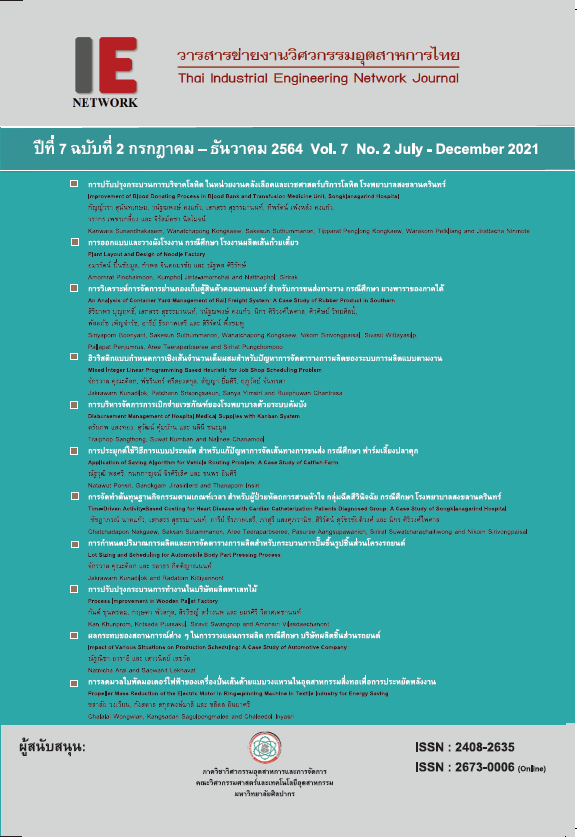Lot Sizing and Scheduling for Automobile Body Part Pressing Process
Main Article Content
Abstract
This research proposed a daily production planning method for an automobile body part pressing machine by using 4-stages mixed integer linear programming model. This research proposed four steps for lot sizing determination. The first stage aims to minimize the maximum tardiness. The second stage uses for minimizing the total weighted tardiness. The third stage uses for maximizing the average earliness. The final stage determines production volumes for each part with minimizing the total cost of holding cost and setup cost as the objective. Next, the decision variables corresponding to the part delivery of the final model were utilized to build the production schedules. The performance of the proposed method was evaluated by comparing with the real production plan of 20 days. The results revealed that the optimal solutions were found for all models of all problems. The total cost was reduced 1.58% and the average completion times of parts produced in their shipping period before delivery were met the delivery restriction. The average computational time for creating the daily production plan was less than one minute comparing to 108 minutes of previous method.
Article Details
บทความ ข้อมูล เนื้อหา รูปภาพ ฯลฯ ที่ได้รับการตีพิมพ์ในวารสารฯ ถือเป็นลิขสิทธิ์ของวารสารฯ หากบุคคลหรือหน่วยงานใดต้องการนำทั้งหมดหรือส่วนหนึ่งส่วนใดไปเผยแพร่ต่อหรือเพื่อกระทำการใดๆ จะได้รับอนุญาต แต่ห้ามนำไปใช้เพื่่อประโยชน์ทางธุรกิจ และห้ามดัดแปลง
References
[2] Drake, M. J., Pentico, D. W., & Toew, C. (2011). Using the EPQ for coordinated planning of a product with partial backordering and its components. Mathematical and Computer Modelling, 53, 359-375.
[3] Pinedo, M.L (2005). Planning & Scheduling in Manufacturing and services. Springer.
[4] รวินท์ธนัตถ์ ทิพย์เสนา. (2556). การวางแผนการผลิตเลนส์แว่นตาพลาสติกที่มีความหลากหลายของผลิตภัณฑ์และอัตราการผลิต. ปริญญาวิศวกรรมศาสตรมหาบัณฑิต, สาขาวิชาวิศวกรรมระบบการผลิต, คณะวิศวกรรมศาสตร์, มหาวิทยาลัยเทคโนโลยีพระจอมเกล้าธนบุรี.
[5] ภิญญามาศ มานะทวีวัฒน์. (2561). แบบจำลองคณิตศาสตร์แบบหลายขั้นตอนสำหรับปัญหาการขนส่งคอยล์โลหะ. วิทยานิพนธ์ปริญญาวิศวกรรมศาสตรมหาบัณฑิต, สาขาวิศวกรรมอุตสาหการ, คณะวิศวกรรมศาสตร์, มหาวิทยาลัยบูรพา.
[6] เพชรายุทธ แซ่หลี และอภิชัย ฤตวิรุฬห์. (2557). แบบจำลองกำหนดการเชิงเส้นจำนวนเต็มสำหรับการวางแผนการผลิตเครื่องสำอางจากสมุนไพร. วารสารวิจัยและพัฒนา, มจธ., 37, 347-360.
[7] ธันยพร อุดม, ภูพงษ์ พงษ์เจริญ และขวัญนิธิ คำเมือง. (2559). การแก้ปัญหาการวางแผนและจัดตารางการผลิตขั้นสูงที่พิจารณาการบำรุงรักษาเชิงป้องกันแบบมีกรอบเวลา โดยตัวแบบกำหนดการจำนวนเต็มแบบผสม. วารสารไทยการวิจัยดำเนินงาน, 4(1), 1-15.
[8] ภัทราภรณ์ สัจจนดำรงค์ และธารทัศน์ โมกขมรรคกุล. (2551). การพัฒนาแผนการผลิตหลักสำหรับอุตสาหกรรมแบบผลิตตามสั่ง. ใน การประชุมวิชาการด้านการวิจัยดำเนินงานแห่งชาติ ประจำปี 2551 (หน้า 229-237).
[9] รัชฎากร โคตรเจริญ. (2554). การวางแผนการผลิตที่มีหลายเป้าหมายด้วยการโปรแกรมเชิงเส้นแบบพอสสิบิลิสติก, กรณีศึกษาโรงงานผลิตชิ้นส่วนอิเล็กทรอนิกส์. วิศวกรรมศาสตรมหาบัณฑิต, สาขาวิชาพัฒนางานอุตสาหกรรม, ภาควิชาวิศวกรรมอุตสาหการ คณะวิศวกรรมศาสตร์, มหาวิทยาลัยธรรมศาสตร์.


